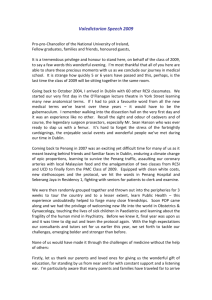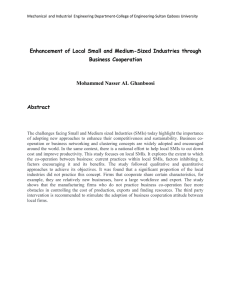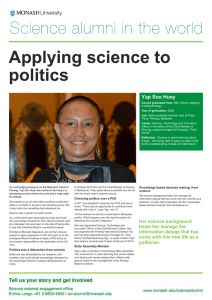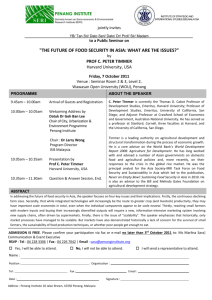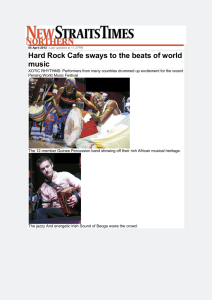Penang’s economy has dramatically transformed from an agriculture and trade-
advertisement
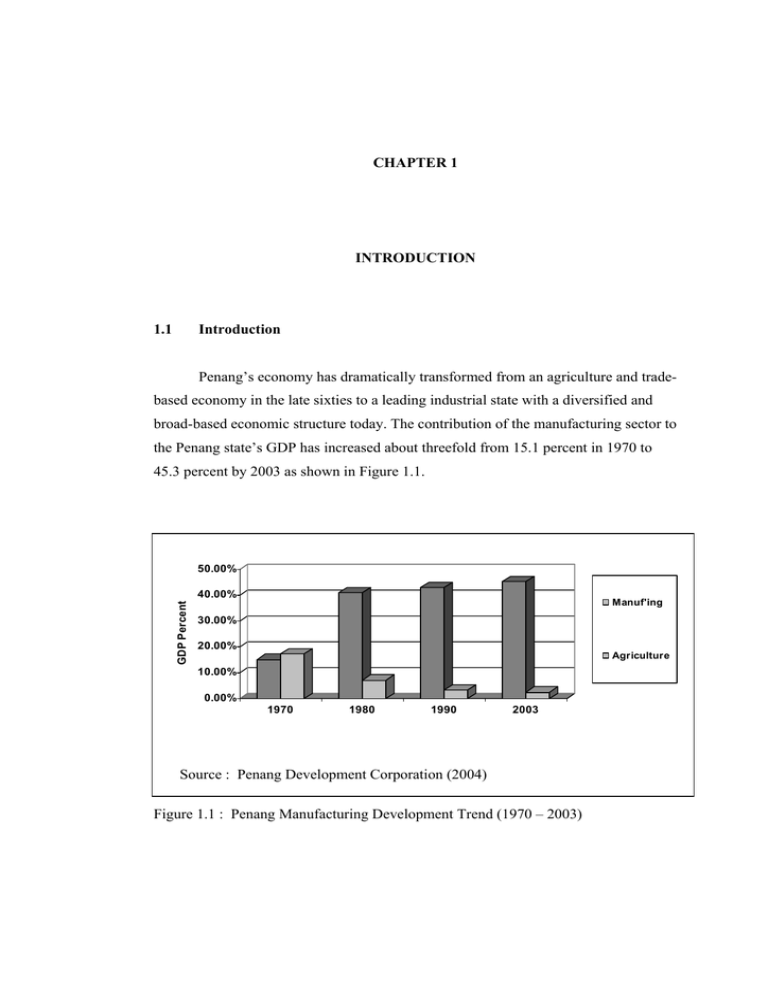
CHAPTER 1 INTRODUCTION 1.1 Introduction Penang’s economy has dramatically transformed from an agriculture and trade- based economy in the late sixties to a leading industrial state with a diversified and broad-based economic structure today. The contribution of the manufacturing sector to the Penang state’s GDP has increased about threefold from 15.1 percent in 1970 to 45.3 percent by 2003 as shown in Figure 1.1. 50.00% GDP Percent 40.00% Manuf'ing 30.00% 20.00% Agriculture 10.00% 0.00% 1970 1980 1990 2003 Source : Penang Development Corporation (2004) Figure 1.1 : Penang Manufacturing Development Trend (1970 – 2003) 2 Penang may have developed its competitive edge in the seventies to nineties, the state now has to contend with increasing competition from the region, as well as from other new emerging economies. In the face of stiff competition from the emergence and continued growth of China, coupled with the very aggressive development of Thailand, Vietnam and India had provided further pressure to Penang as a viable investment destination. All markets after AFTA implementation by 2010 will be open and accessibility will be based on merit of quality, pricing, market niches and cultural preferences. In this very open system, it becomes vital to develop the right programmes and strategies for the Penang SMIs in electronics and electrical manufacturing industry. The competitive and very challenging global environment for investments has results in slowdown in inflows of FDI to Penang as shown in Figure 1.2. 5 4 3 FDI (RM B) 2 1 0 1997 1998 1999 2000 2001 2002 2003 2004 Year 1997 1998 1999 2000 2001 2002 2003 2004 FDI (RM) 0.42B 1.28B 4.60B 3.56B 3.58B 1.99B 1.46B 1.02B Source : Malaysian Industrial Development Authority (2005) Figure 1.2 : Penang Manufacturing FDI Trend Data (1997-2004) 3 PSG (2001-a) pointed out that in light of those changes, with the right strategies on strengthening the competitiveness of the small and medium industries in Penang electronics and electrical manufacturing industry, Penang needs to improve the existing linkages programmes and incentive schemes to broaden and deepen its economic base. Major issues that hinder the realization of the full development potential of each sector of the linkage programmes and strategies have to be identified and analyzed. Development strategies and linkage programmes need to be high-lighted and strategies formulated. All these should take into consideration the broader context of future national, regional and international trends. These strategies and programmes should see Penang as a major recipient of international investment, as it shifts to higher value-added manufacturing activities. 1.2 Problem Statement Due to the present economics slowdown, coupled with the increasing competition from those new economics, Penang small and medium industries in electronics and electrical manufacturing industry need to enhance global competitiveness through improving linkage programmes. 1.3 Research Objective The main objective of this research study is to highlight the important issues as recommendations to the Penang state authority in formulating action plans and strategies through effective linkage programmes. From the main objective above, the following are the sub-objectives of the research : a) To identify problems of SMIs in Penang electronics and electrical manufacturing industry; 4 b) To determine the important factors that contribute to the competitiveness of SMIs in Penang electronics and electrical manufacturing industry; c) To identify the perception of industries (MNCs and SMIs) on variables affecting SMIs in Penang electronics and electrical manufacturing industry performance; d) To identify the challenges and expectation from SMIs in Penang electronics and electrical manufacturing industry. 1.4 Research Hypothesis Brain storming and discussion sessions were carried out with few industrialists and government agencies on the core issues faced by the Penang’s manufacturing industry, lead to the development of the Hypothesis as listed below. Through the survey interviews with various industry professional from SMIs and MNCs, the following hypothesis which are related to linkage programmes and improvement strategies will be verified :a) Hypothesis #1 Penang’s manufacturing industry still have the potential to revive once the global economy situation improves. b) Hypothesis #2 Technological and managerial skills of most Penang manufacturing industry’s SMIs have met the requirements of the MNCs expectations. c) Hypothesis #3 Government have provided sufficient information, guidance and assistance to SMIs on exporting their products. 5 d) Hypothesis #4 The key expectation from SMIs through the linkage programme is for technological improvement, rather than the company’s profitability. e) Hypothesis #5 SMIs need to expand their utilization of Information and Communication Technology (ICT) in order to be competitive in technology and marketing. f) Hypothesis #6 Present industrial development incentives and schemes are effective and impressive enough as compared to other countries to attract new investors and retain existing investors. g) Hypothesis #7 Existing linkage programmes for SMIs need to be further reviewed and improved to meet present technological and market competitiveness requirements. h) Hypothesis #8 The present increasing overhead and labour costs are the main factors for Penang’s manufacturing industry to lose out in the global market. i) Hypothesis #9 Electronics and electronics industries will still remains as the main steam of the manufacturing sectors in Penang for the next five years. j) Hypothesis #10 As compared with other industrial developed countries, Penang is still remains a top choice for manufacturing industry set up by foreign investors. 6 1.5 Scope This research is confines to the small and medium industries in Penang electronics and electrical manufacturing industry. 1.6 Importance of this Research This research study will contribute to a better understanding of problems involved in development of SMIs in electronics and electrical manufacturing industry in Penang which can be summarized as follows :a. To help SMIs expand their business and manufacturing activities which can bring in more government revenue; b. To assist SMIs in expanding and diversifying the industrial base of the state towards enhancing international competitiveness, increase the valueadd in products and exports, domestic investments, employment opportunities and hence the standard of living and quality of life of the people; c. To develop improvement strategies on how SMIs and MNCs can work together to increase the productivity and economic viability of the state towards the common goal of a more prosperous and progressive Penang; d. To re-orientate the government to be more service-oriented in its approach so as to provide a more conducive environment for SMIs to operate profitably, as well as to expand as rapidly as possible to generate more profits. In essence, the rationale of the innovative linkage programme and improvement strategy is to increase productivity and international competitiveness towards sustaining, if not, further improving the economic growth of the state. Through this programme, greater progress can be achieved so that Penang can realize 7 her vision of becoming an industrialized state by the year 2020, as emphasized by the ex- Prime Minister Tun Dr. Mahathir Bin Mohamad (Mahathir, 1997). This research study is in line with the 2nd Penang Strategic Development Plan (PSDP2) – 2001 to 2010 (PSG, 2001-a) which is strongly based on the concept of SUSTAINABILITY in heading towards Vision 2020 of Malaysia is as shown in Figure 1.3 (PDC, 2003-a). This study met PSDP2 expectation by looking into the improvement and remedial measures on two of the five major thrusts, i.e., economic competitiveness and external linkages. Vision 2020 PSDP2 SUSTAINABILITY Economic Competitiveness Ecological Balance Caring and Sharing Cultural Vibrancy External Linkage - Economic - Environment - Social - Culture - Globalization Good Governance (Public and Private) Source : Penang Development Corporation, PSDP2, 2003 Figure 1.3 : Five Major Thrusts for Sustainability in Penang 8 1.7 Research Methodology This research was conducted in three parts : In the first part of this study, a review was conducted on the existing literature on the industry, both in Penang and internationally, with a particular focus on the problems and activities of SMIs on electronics and electrical manufacturing industry. This included academic, official and public sources. The academic sources consisted of books, journal articles and graduate/ undergraduate report on various aspects of the SMIs in Penang and others countries. The official sources included studies and previous surveys of the SMIs in Penang, conducted by government and semi- government bodies. The public sources consisted of articles from local and foreign newspapers, magazines and websites. A summary of the relevant material is presented in the reference section. The second part of the research collected aggregate data on the SMIs for electronics and electrical manufacturing industry drawn mainly from the annual census of industrial production conducted by the Malaysia Department of Statistics (DOS, 2003), MIDA, PDC, SERI and DCT Consultancy Services. These data provide a better understanding of the performance of the electronics and electrical industry in Penang. The third part of the research involve a face-to-face interview or personal delivery of survey questionnaire to 115 firms and organizations whose activities are related to electronics and electrical manufacturing industry in Penang. Each in depth survey interview lasting from one to two hour were conducted with the CEO, managing director, proprietors, top and middle management personnel of the SMIs and MNCs. The interviews were conducted through the month of December 2002 to June 2003. A questionnaire was designed consisting of 50 questions (Appendix K). Information gathered was qualitative as well as quantitative in nature. Valuable insights into the problems and suggestions on improvement were obtained as a result of the interviews. The material and data from the interviews are analyzed and presented in chapter V. 9 1.8 Thesis Outline This thesis consists of seven chapters, as described in the table of contents. Chapter I - Introduction This chapter sums up the needs, objectives, benefits, hypothesis statements and research methodology of this study. Chapter II - Literature Review This chapter reviews the merits and benefits of linkage programmes and strategies for SMIs in the manufacturing industry. Chapter III - Overview of SMIs in Penang Manufacturing Industry This chapter outlines the overview of the manufacturing industry’s SMIs in Penang, followed up with the experiences from other industrial developed countries on their SMIs development programmes and strategies. Chapter IV - Research Mathodology This chapter looks through the research methodology which examines the research design on development of questionnaires and structured interviews. Chapter V - Data Analysis This chapter analyses on the data collected from the survey interviews, the Hypothesis are tested and the results presented. Chapter VI - Strategies and Programmes Implementation This chapter describes the development and implementation plan of the innovative linkage programmes and improvement strategies. Chapter VII - Conclusion This conclusion chapter summarizes the finding of the research study. 10 1.9 Summary In this chapter, the author have developed a clear objective, listed out all Hypothesis, discussed the research outlines, methodology and benefits from this research study. This is formulated into a conceptual framework for a more systematic procedure to commence the research.
